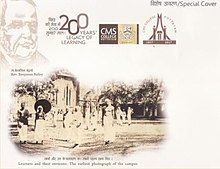Saint Thomas Anglicans
[7] This happened due to the influence of the Church Mission Society missionaries, who laboured amongst the Oriental Orthodox Christians of Travancore.
Col Munro persuaded Rani Gowri Lakshmi Bayi of Travancore, with whom he was on very good terms to donate land in Kottayam as well as the money and timber, in-order to build the Orthodox Pazhaya Seminary (founded 1815) for the Malankara Church.
[28][30] In the coming years, several pious Christian men like Benjamin Bailey, Joseph Fenn and Henry Baker (Sr) arrived in Kottayam and worked at the Pazhaya Seminary and among the Malankara Syrians.
[36][37][38] The earliest British missionaries shared warm cordial ties with the successive Malankara Metropolitans of their time and were sensitive to their apprehensions and bearing.
This is evident from the words of Mar Dionysius III, in his letter to the President of the CMS Lord Gambier, in which the Metropolitan likens Resident Colin Macaulay to Moses, Rev.
Claudius Buchanan to Aaron, Resident John Munro to Joshua and expresses heartfelt gratitude to the missionaries, for their services to his Church.
The younger missionaries who arrived later were uncompromising evangelists who insisted on major reforms to faith and doctrines of the Malankara Church, which the changed Jacobite leadership didn't want.
[44] The Syrians, who bore the scars of the Portuguese Inquisition, felt that the excessive interest shown by the British in their Church, was indicative of an impending hostile take over.
[45] The discord and misgivings eventually led to the 1836 Synod of Mavelikkara, in which the Malankara Syrian Community under Mar Dionysius IV, decided to keep all their age-old traditional practices and be subject to the authority of the Syriac Orthodox Patriarch of Antioch.
This Anglican Syrian community was initially concentrated in the regions of Kottayam, Thiruvalla, Mallapally and Mavelikkara, where the missionaries had earlier worked with the Jacobites.
[50] In the beginning, they worshipped using a Malayalam adaptation of the West Syriac Liturgy of Saint James, which did not have ingredients considered unscriptural by Anglicans.
[52][53] The social order of 19th century Travancore was based on a rigid caste system, which served as the backbone of its agricultural subsistence economy and hence reinforced harshly by local rulers.
[59][53] They set up a network of educational institutions, staffed by well-trained Anglican Syrians, to draw upper castes to their missions.
[59][53][61] The younger missionaries, believed that the slave classes have suffered long enough and any procrastination on their part, to improve the conditions of outcastes, was very unchristian.
[72][53] As the Syrians understood it, caste was an essential Character Indelebilis, received by birth, which remains unaffected by one's religious faith, change of it, or even lack thereof.
In Thalavady, when a British missionary brought in low caste converts to a Syrian–Anglican congregation, the Syrians leaped out through the windows and fled.
[75][53][76] St. Thomas Christians shared the prevalent view among higher castes that slaves, once enlightened, may no longer be docile; a very undesirable change that could ultimately lead up to their regrettable liberation.
[83][8] Albeit being a minority, early access to Western-style education, enabled Anglican Syrian Christians to achieve positions of leadership in government and society, that was perceptibly disproportionate to their share of the population.
[93][94] The pressure for the Indianization of the Anglican Church for the greater good, originally came from the British churchmen, serving in India, from last decades of the 19th century.
[102][15][16] They also insisted that all ordinations after the union should be exclusively episcopal, conferred only by existing bishops with the imposition of hands, so that in the fullness of time, the entire ministry of the United Church would be in apostolic succession.
[113] While the CSI liturgy and rite was being developed, there was a recommendation to observe the Kiss of Peace with congregational participation, as in the local Syrian Churches.
Malankara Syrians actually passed greetings hand-to-hand throughout the entire congregation, unlike in the Western Church, where it was greatly reduced or limited to the clergy.
[12] In the celebration of 1916, that marked the centenary of the CMS mission to Travancore, the head bishops and clergy of the various Syrian factions thankfully acknowledged how much they owed the missionaries, who gave them the Bible in Malayalam as well as Syriac, and reminisced the multitude of Malankara Syrians that passed through the CMS College[12][120] Ever since, the relation between Anglican and Orthodox Churches has been of friendly cooperation.
[123][124] Many of these congregations are outside the South Indian Anglican province and hence fall under the ecclesiastical jurisdiction of the respective provincial bishops, at least technically.
[125] Hence, the task of determining the cumulative number of Syrian Christians in the South Indian and other global Anglican provinces, is quite challenging.
[126][127][128] The association with the Church Mission Society, worked to the advantage of Anglican Syrian Christians, for they soon surfaced as a community of several firsts.
[139][140][141] Padma Vibhushan Dr. John Matthai was the first Malayali to become a cabinet minister for independent India, handling Railways and later Finance portfolios.
[149] This eventually brought forth the Travancore Christian Succession Act of 1916, although a daughter's share in ancestral property, in lieu of dowry, was limited to a 4th of that of a son, due to fierce opposition from conservative Syrians.
[158][159] Independent scholars like Dr. Robin Jeffrey have opined that the death of Mr. Kuruvilla, prior to his son's marriage, along with the unqualified support Mary received from her well-educated husband, may have contributed positively to the building of her exemplary career.
[161] Historical facets of Saint Thomas Anglican life and culture like missionaries, Syrianness, casteism, slaves, bygone Anglophilia etc.







